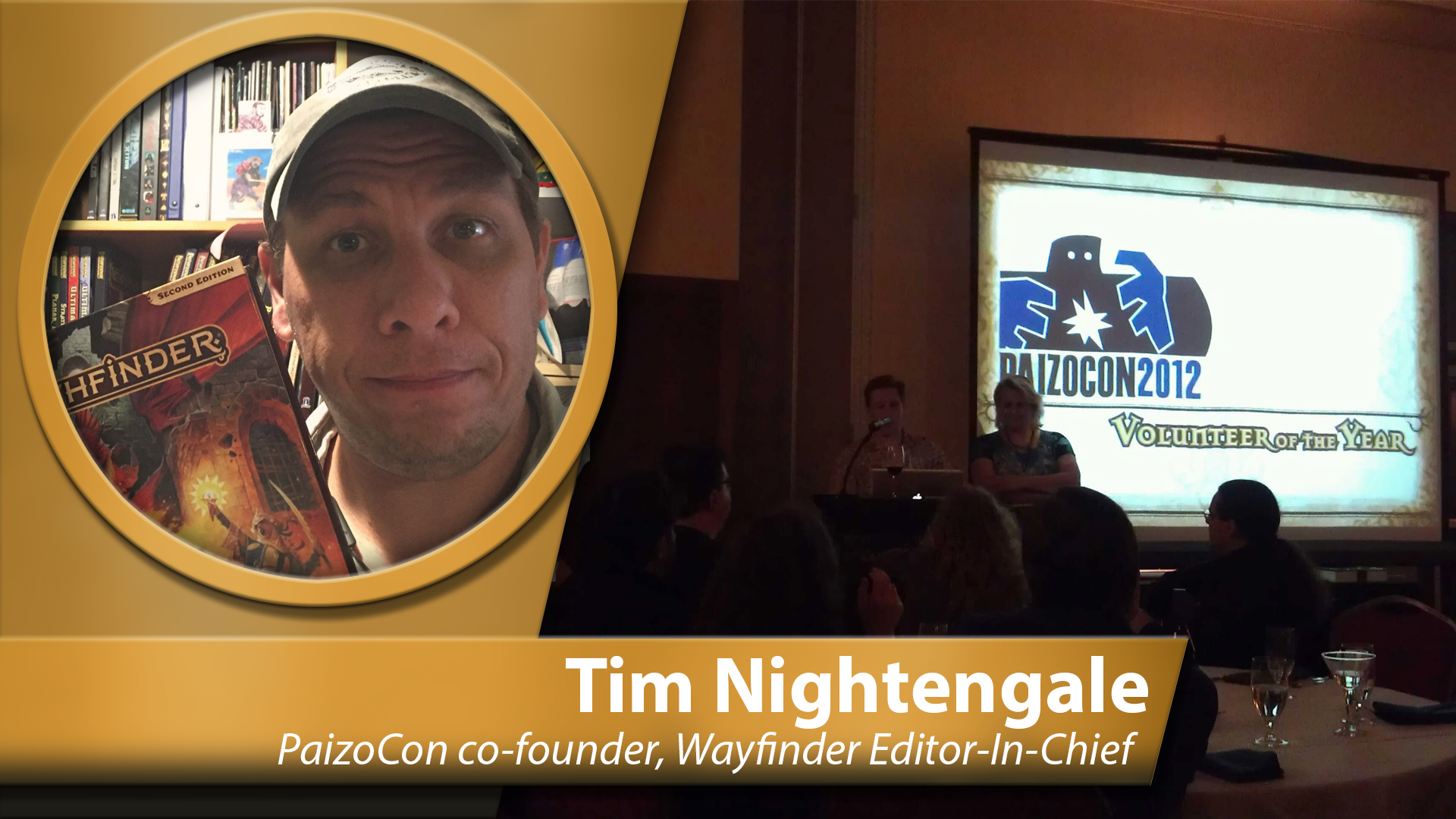By Tim Nightengale
One of the biggest hurdles to starting out in the tabletop gaming industry seems to be just that…figuring out where to start. Now, you could be lucky enough to know someone in the gaming industry and then find yourself frequenting those circles. You could start writing content and posting on a blog, website, or forum, and share links like crazy so that one day someone in the industry hears about you, or stumbles across your creations. Or you could compete in writing competitions sponsored by gaming publishers or websites that are looking for the next great freelancer. All possibilities, sure. However, they are all pretty much long shots. So, what other options do you have?
Well, have you heard of Wayfinder?
I know I shouldn’t be, but I am still surprised when I find Pathfinder or Starfinder fans that have never heard of Wayfinder. Maybe, though, you are a Paizo fan that has heard of Wayfinder, but you don’t really know much about it other than it’s a free fanzine with fan-created content. So, for this Very Special Guest Blog, I’d like to share with you exactly what Wayfinder is…perhaps the easiest and most surefire way to get your foot in the door of the gaming industry.
It didn’t start out that way, though. Oh, no, no. It started out as a fan project created as “a love letter to Paizo.” I’m not going to get into the history of how Wayfinder got started. For that story, give a listen to Know Direction 157. Suffice to say, Wayfinder was started as a little fan-made magazine to hand out at PaizoCon. Because PaizoCon was founded on the concept of fan appreciation for Paizo, Wayfinder was another way to let fans dip their collective toe in the waters of Golarion, via the Community Use Policy, and show the Paizo staff how much Pathfinder meant to us, the fans.
That’s the way things went for several issues, until PaizoCon 2012. As had become a tradition, I was at the PaizoCon Meet and Greet that I hosted each year (before PaizoCon got way too big) handing out early copies to contributors of the magazine as a treat and thank you for their work. This is always a fun experience, seeing the initial reactions and smiles at our finished product. This year, however, I remember handing the issue to a first-time contributor. They accepted the copy with trembling hands, carefully turned the pages until they got to their article and looked back up at me with tears in their eyes. “I never thought I’d ever see my work in print. Thank you.”
This stunned me. This was my third issue at the helm of Wayfinder, and for me the fanzine was a fun community project that let me play with ideas and concepts with other fans. I had never once considered how important it might be for a new writer or artist to see their work in print. Later during that PaizoCon, several third-party publishers I knew came up to me to ask for contact information on a few authors and artists as well. I came away from that PaizoCon with a new realization about Wayfinder: it was becoming a potential gateway into the RPG industry.
There have been a dozen issues of Wayfinder since PaizoCon 2012. I’d like to think that each issue tops the last one, but what I am most proud of is the number of authors, editors, and artists that have found starting success with Wayfinder, and have moved on to contribute to Paizo and other gaming publishers. That’s PAID gigs, folks! I remember sitting in a freelancer meeting at PaizoCon one year and noticing how many people in the room had Wayfinder credits. It was a little surreal.
So, now that you’ve read all this, as a reader new to this “Wayfinder” thing, you might be wondering exactly how Wayfinder might help YOU catch a break in the RPG industry. In order to do this, I must explain how Wayfinder works. First, we set a theme for an issue. This is usually set up around a place in the campaign setting, particularly if an Adventure Path (AP) takes place there. We try to pick a theme that has a lot of Paizo published material about it. The thinking is that if Paizo is “done” making content on this region, then there is no risk of our fan-generated content being over-ruled by new official Paizo content. Currently, our 2020 issue is the Starfinder theme “The Diaspora”.
After we pick a theme, we post an open call for submissions (and the established guidelines) on the Paizo Forums, under the Paizo\Community Use subforum. We keep it open for about 5 months (our current open call closes on October 31, 2019). In our downtime between issues, we build our volunteer rosters of editors and artists. Articles need to be edited, and they need illustrations, right? We need people to help do that. So, not only can you get experience writing gaming content, but you can also get editor experience, and create illustrations to include in your portfolio that have been published. That’s important.
After the call closes, OUR work begins. We review all the submissions and select about 45 entries to be in the issue. We then assign several articles to each of our editors for two rounds of editing. This can be a collaborative experience, with author and editor working together to polish the article…but not always. Each round has a different editor. A third round is completed by the assistant editors, mostly to address formatting and check for anything that stands out as odd or wrong. The final pass is done by me, the Editor-in-Chief, to make sure that everything looks good. There is also a proof-reading pass done at the end of layout, when all the editors get a chance to go through and hunt down typos and errors. So, our issue is very thorough in editing.
While all that is going on, the Art Director (i.e., me), goes through each article and assigns them to artists on our roster. I try and match content to artist style, so that artists get a challenge, but nothing too far outside their comfort zone or range. Artists typically get 2-3 assigned illustrations, and 6-8 weeks to complete them. I write fairly detailed art orders for each piece, explaining what I envision, but I also include the original article text, so that the artist has the full context of what we are asking them to illustrate. Often, the artist makes significant improvements to the illustration that I could never suggest, because I’m not the artist. They are. It is a good collaborative effort that produces some of the best art I could ever want.
When all the pieces are in place, it all goes to layout, and comes together as the final magazine. That is a supreme understatement, though. Dain does an amazing job, and the magazine looks as good as it does because of his efforts. We upload the final PDF to Paizo.com for free download to the public at the start of each PaizoCon.
From there, it all comes down to who sees the issue. I know that Paizo staff definitely reads Wayfinder, and often finds new freelancers and artists to check out through the ‘zine. It’s on the reading list of several third-party publishers as well. Paramount to all of this, we try and promote our authors, editors, and artists as much as possible. Posts and shares on Facebook, Twitter, posts in the Paizo Forums. I co-host a DeviantArt group that compiles art for each issue for people to find and view as well Interviews on Know Direction. In digital age, social media is key, but I know we probably don’t do enough. So, that’s where we can always use some help from the fans. Spread the word. Read the issue and post a review, either in the Paizo store, or on your own blog.
The talent is out there…and the talent is YOU. Wayfinder is a way to find you.
About Tim Nightengale
Tim Nightengale started out in the gaming industry as a “Friend of Paizo” playing in Jason Bulmahn’s Eberron campaign in the Paizo office. It was a case of having a good friend who worked at Paizo and being in the right place at the right time. From there, a casual conversation of “hey, you’ve gamed with us for a while, now. Why aren’t you writing for us?” began a freelancing venture in monster creation that has spanned several APs and a couple of bestiary hardcovers. Along the way, Tim managed to find himself in a few other Paizo office campaigns, which reached a pinnacle when his character became canon in the Pathfinder world. Admit it, that is kind of the ultimate thing for a gamer, right? However, he might be best known for starting PaizoCon with fellow fan Liz Courts back in 2008 in the basement of a LaQuinta (this is the stuff of legends!). Liz also slyly tricked him into taking the helm of the Wayfinder fanzine at issue #5. Serving as Editor-in-Chief for 15 issues now (one winning a Gold ENnie), Tim seems to not quite ready to let Wayfinder go – or is it the other way around?






